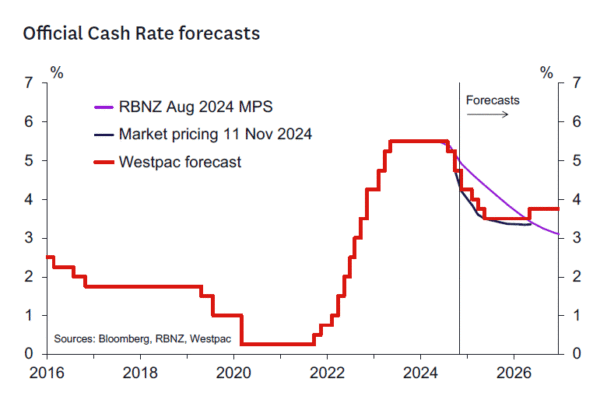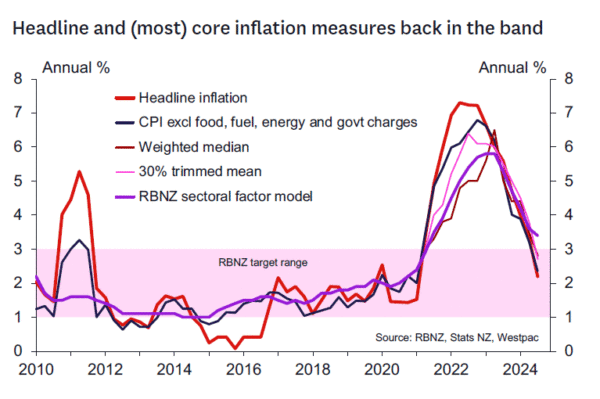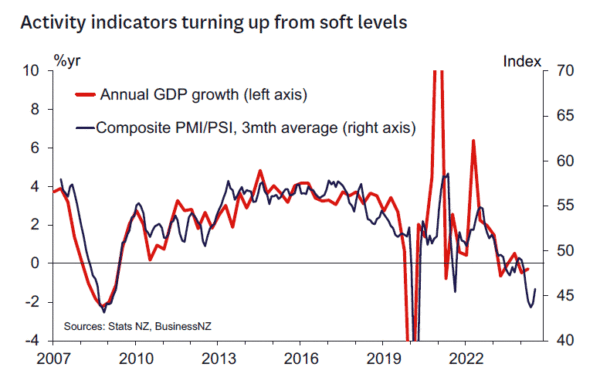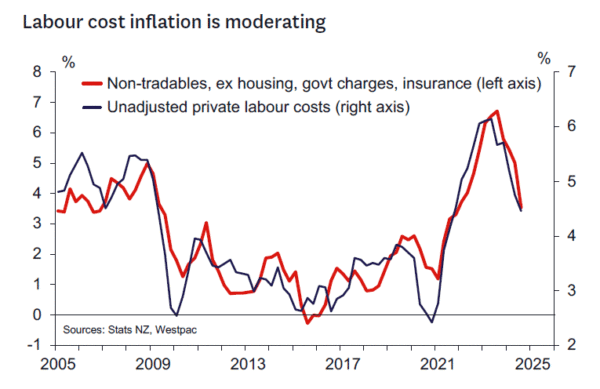- We expect the RBNZ will cut the OCR by a further 50bps to 4.25% at its November Monetary Policy Statement meeting.
- The RBNZ will likely indicate increased confidence that pricing and wage setting behaviour will quickly normalise now that annual CPI inflation is close to 2%.
- The RBNZ’s projections will likely suggest further OCR cuts in 2025 and a 3.5% OCR by year-end (around 35bps lower than they forecast back in August). The RBNZ’s terminal rate will likely still be in the 3-3.5% zone after 2025.
- Near-term CPI projections should be revised down modestly, reflecting the better starting point.
- We are not expecting major changes to the Bank’s economic growth projections, although recent improvements in commodity prices and a slightly more front-loaded easing cycle might lift near-term growth at the margin.
- The RBNZ will likely acknowledge the elevated geopolitical risks associated with political change in the US, which could impact the NZD and tradable inflation going forward. Few conclusions will be drawn given the significant uncertainties.
RBNZ decision and associated communication – our baseline scenario.
Our baseline scenario sees the RBNZ cutting the OCR by 50bp to 4.25% at its November policy meeting. We also expect that the RBNZ will revise down their OCR forecast profile to be consistent with the OCR reaching around 3.5% by the end of 2025 (compared with 3.85% in the August MPS).
At the end of this note we summarise key data and developments over the past few months. Based on the latest information to hand, we think the RBNZ will:
- express comfort that lower headline inflation (now at 2.2%y/y) gives confidence that price setting behaviour and inflation expectations will be consistent with inflation around 2% on an ongoing basis;
- explain that this confidence has allowed for more front-loading of the easing cycle, resulting in the OCR being cut by 50bps in October and again this month;
- note that recent activity and employment trends remain broadly in line with expectations;
- continue to point to elevated non-tradables inflation, so that restrictive conditions and a negative output gap remain appropriate for a while to squeeze out the last of those inflation pressures;
- acknowledge the riskier geopolitical environment, but draw no strong conclusions at this point aside from noting that NZ’s floating exchange rate will help buffer adverse external shocks that eventuate; and
- provide guidance that if the economic outlook evolves as anticipated, the pace of easing will slow in 2025 as the OCR draws closer to the neutral zone.
Alternative scenarios.
Around that baseline scenario, to which we attach a 50% probability, we see four other potential outcomes at next week’s policy meeting:
- Hawkish scenario (15% probability): 25bp cut. The RBNZ might opt for a smaller cut, noting that the starting point for the economy has not been quite as weak as depicted in the August MPS and that downside risks appear less prominent. As part of that scenario the RBNZ could revise up their neutral OCR to 3-3.25%, reflecting higher long-term interest rates in NZ and abroad. Risks around the exchange rate and the sustainability of weak tradable inflation could be highlighted, as could the more elevated pricing intentions trends in the ANZ’s business survey. Stronger NZ commodity export prices – especially dairy prices – could also be seen as supporting the medium-term outlook.
- Moderately hawkish scenario (20% probability): 50bp cut but only slightly reduced end-2025 OCR forecast. The RBNZ would signal ongoing cuts at the MPS meetings in the first half of 2025 but to an end 2025 level of around 3.75%, perhaps due to concerns that ongoing disinflation in tradables might be less sustainable given downside risks to the exchange rate. Signs of a rebound in activity in the housing market and business surveys might also cause the RBNZ to project a more cautious approach in 2025 as the neutral zone for the OCR approaches.
- Moderately dovish scenario (10% probability): 50bp cut and end 2025 forecast OCR revised down to market pricing levels of around 3.25%. The RBNZ could largely endorse market pricing, with a move towards a 3% terminal OCR projected to be largely completed by the end of 2025. The RBNZ would need to be willing to signal high confidence that wage and price setting behaviours have normalised, and that upside inflation risks seem modest.
- Dovish scenario (5% probability): 75bp cut. The RBNZ would be signalling high confidence that inflation will remain no higher than 2% and perhaps concern that the recovery in economic activity might be more sluggish than hoped. Thereafter, 50bp cuts would seem most likely at the February 2025 MPS and April MPR meetings as the OCR is pushed to 3% by mid- 2025. We don’t think the RBNZ would signal a move in the OCR below 3% in 2025 but the risks that this might ultimately be required could be noted. This could especially be the case if the RBNZ sees predominantly downside risks coming from recent geopolitical trends (e.g., China deflation, or an unjustified rise in global long-term interest rates).
Key developments since the August Monetary Policy Statement.
Key economic developments since the RBNZ’s last policy statement in August are noted below. We suspect that the RBNZ will conclude that activity and pricing indicators released since the August projections provide a basis for increased confidence that inflation will track close to the midpoint of the 1-3% target range on a sustained basis.
- Inflation: September quarter inflation was a touch softer than the RBNZ forecast (+2.2%yr vs August MPS forecast +2.3%). Lower tradables and especially energy prices explain much off the move lower in headline inflation. In contrast, non-tradables inflation has been easing more gradually, albeit with some clear progress lower once government charges are excluded. Lower tradables inflation means some chance the RBNZ will project headline inflation a little below 2% for a brief period.
- Inflation expectations/pricing indicators: On balance, most gauges of cost and pricing pressures are looking increasingly consistent with the RBNZ’s medium term target (the ANZ business survey’s pricing intentions index being in the notable exception). Similarly, surveys of inflation expectations are now back at levels consistent with the RBNZ’s inflation target or at least at around the levels normally seen when inflation is running close to the target midpoint.
- Activity: The 0.2% fall in June quarter GDP was not as weak as we or the RBNZ expected. More recently, business activity indicators have improved but remain subdued and so suggest another modest decline in GDP in Q3. However, we are seeing signs that the downturn in domestic activity is flattening off. For instance, retail spending has started to push higher since August and residential consent numbers appear to have found a base following sharp declines over the past couple of years. Forward sentiment indicators in the QSBO and ANZ business survey have continued to improve in recent months as respondents have factored more neutral policy settings into their forecasts.
- Labour market: The labour market is tracking no weaker than expected. The unemployment rate didn’t rise as much as the RBNZ feared (4.8% vs 5%) but employment growth and labour costs were a touch weaker than expected – the latter consistent with the slowdown in inflation seen in private sector services prices. Recent trends in filled jobs appear consistent with the RBNZ’s August forecast that employment will fall only modestly further in the current quarter. Any RBNZ concerns of a larger shakeout in the labour market have probably been assuaged by recent data (including more positive hiring intentions surveys, albeit advertised job vacancies are yet to improve).
- Housing market/population growth: House sales are yet to show much improvement from subdued levels, while house prices have continued to track sideways at best with prospective buyers able to select from a significant level of inventory. However, mortgage applications have picked up and both anecdotal evidence and housing surveys point to a prospective increase in activity over coming months. So, on balance we would not expect much change in the RBNZ’s forecasts for the housing market. That said, it is possible that the RBNZ might slightly lower its forecasts for net migrant inflows.
- Commodity prices/exchange rate: Overall, commodity prices are on the rise. That includes dairy prices, which have been bid up at the recent global dairy trade auctions (as reflected in Fonterra’s decision this week to raise its forecast milk payout for the current season). Prices for meat, New Zealand’s other major export category, have also lifted off the back of increasingly favourable demand and supply fundamentals. As noted below, there are some downside risks to the NZ dollar, although at present the trade-weighted exchange rate index (TWI) is trading slightly firmer than the 69.5 assumption made in the August MPS.
- Geopolitical developments: War in the Middle East has intensified but to date oil prices haven’t been impacted and risk sentiment remains strong. The key development is Trump’s resounding win in the US presidential election and Republican control of the Senate and (likely) the House. Global markets have moved to price in the expected impact of Trump’s relatively unimpeded policy program. The implications are higher US growth, inflation, interest rates and the US dollar, although the exact magnitude is uncertain. For New Zealand, developments on the global stage signal potentially significant risks to export incomes over the medium-term. We may see short-term downside risks to energy and import prices should Russian oil be better able to reach global markets through eased sanctions after a brokered ceasefire in Ukraine, and if Chinese manufactured goods need to find an alternate destination due to US tariffs. However, short-term inflation benefits could be at least partially offset by a weaker NZD. On balance these developments confer more risk to the outlook which could make the RBNZ more cautious on the medium-term inflation outlook.


















